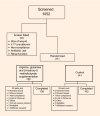Effect of oral nutritional supplementation on wound healing in diabetic foot ulcers: a prospective randomized controlled trial
- PMID: 24867069
- PMCID: PMC4232867
- DOI: 10.1111/dme.12509
Effect of oral nutritional supplementation on wound healing in diabetic foot ulcers: a prospective randomized controlled trial
Abstract
Aims: Among people with diabetes, 10-25% will experience a foot ulcer. Research has shown that supplementation with arginine, glutamine and β-hydroxy-β-methylbutyrate may improve wound repair. This study tested whether such supplementation would improve healing of foot ulcers in persons with diabetes.
Methods: Along with standard of care, 270 subjects received, in a double-blinded fashion, (twice per day) either arginine, glutamine and β-hydroxy-β-methylbutyrate or a control drink for 16 weeks. The proportion of subjects with total wound closure and time to complete healing was assessed. In a post-hoc analysis, the interaction of serum albumin or limb perfusion, as measured by ankle-brachial index, and supplementation on healing was investigated.
Results: Overall, there were no group differences in wound closure or time to wound healing at week 16. However, in subjects with an albumin level of ≤ 40 g/l and/or an ankle-brachial index of < 1.0, a significantly greater proportion of subjects in the arginine, glutamine and β-hydroxy-β-methylbutyrate group healed at week 16 compared with control subjects (P = 0.03 and 0.008, respectively). Those with low albumin or decreased limb perfusion in the supplementation group were 1.70 (95% CI 1.04-2.79) and 1.66 (95% CI 1.15-2.38) times more likely to heal.
Conclusions: While no differences in healing were identified with supplementation in non-ischaemic patients or those with normal albumin, addition of arginine, glutamine and β-hydroxy-β-methylbutyrate as an adjunct to standard of care may improve healing of diabetic foot ulcers in patients with risk of poor limb perfusion and/or low albumin levels. Further investigation involving arginine, glutamine and β-hydroxy-β-methylbutyrate in these high-risk subgroups might prove clinically valuable.
© 2014 The Authors. Diabetic Medicine published by John Wiley & Sons Ltd on behalf of Diabetes UK.
Figures





References
-
- Mills JL, Conte MS, Armstrong DG, Pomposelli FB, Schanzer A, Sidawy AN, et al. The society for vascular surgery lower extremity threatened limb classification system: risk stratification based on wound, ischemia, and foot infection (WIfI) J Vasc Surg. 2014;59:220–234. - PubMed
-
- Armstrong DG, Lavery LA, Harkless LB. Validation of a diabetic wound classification system. The contribution of depth, infection, and ischemia to risk of amputation. Diabetes Care. 1998;21:855–859. - PubMed
-
- Oyibo SO, Jude EB, Tarawneh I, Nguyen HC, Harkless LB, Boulton AJ. A comparison of two diabetic foot ulcer classification systems: the Wagner and the University of Texas wound classification systems. Diabetes Care. 2001;24:84–88. - PubMed
-
- Oyibo SO, Jude EB, Tarawneh I, Nguyen HC, Armstrong DG, Harkless LB, et al. The effects of ulcer size and site, patient’s age, sex and type and duration of diabetes on the outcome of diabetic foot ulcers. Diabet Med. 2001;18:133–138. - PubMed
Publication types
MeSH terms
Substances
LinkOut - more resources
Full Text Sources
Other Literature Sources
Medical

